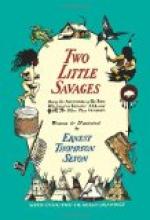“What wood? Some bloomin’ foreign kind that no White-man never saw nor heard of before?”
“No sir-ree. There ain’t anything better ’n White Pine for target and Ash or Hickory for hunting arrows. Which are we making?”
“I’m a hunter. Give me huntin’ arrows every time. What’s needed next?”
“Seasoned Ash twenty-five inches long, split to three-eighths of an inch thick, hot glue, and turkey-wing feathers.”
“I’ll get the feathers and let you do the rest,” said Sam, producing a bundle of turkey-wings, laid away as stove-dusters, and then belied his own statement by getting a block of Ash and splitting it up, halving it each time till he had a pile of two dozen straight sticks about three-quarters of an inch thick.
Yan took one and began with his knife to whittle it down to proper size and shape, but Sam said, “I can do better than that,” then took the lot to the workbench and set to work with a smoothing plane. Yan looked worried and finally said:
“Injuns didn’t have planes.”
“Nor jack-knives neither,” was the retort.
That was true, and yet somehow Yan’s ideal that he hankered after was the pre-Columbian Indian, the one who had no White-man’s help or tools.
“It seems to me it’d be more Injun to make these with just what we get in the woods. The Injuns didn’t have jack-knives, but they had sharp flints in the old days.”
“Yan, you go ahead with a sharp stone. You’ll find lots on the road if you take off your shoes and walk barefoot—awful sharp; an’ I’ll go ahead with the smoothing plane an’ see who wins.”
Yan was not satisfied, but he contented himself with promising that he would some day make some arrows of Arrow-wood shoots and now he would finish at least one with his knife. He did so, but Sam, in the meantime, made six much better ones with the smoothing plane.
“What about heads?” said he.
“I’ve been thinking,” was the reply. “Of course the Indians used stone heads fastened on with sinew, but we haven’t got the stuff to do that. Bought heads of iron with a ferrule for the end of the arrow are best, but we can’t get them. Bone heads and horn heads will do. I made some fine ones once filing bones into the shape, but they were awfully brittle; and I made some more of big nails cut off and set in with a lashing of fine wire around the end to stop the wood splitting. Some Indian arrows have no point but the stick sharpened after it’s scorched to harden it.”
[Illustration: SIX SAMPLE ARROWS, SHOWING DIFFERENT FEATHERS]
“That sounds easy enough for me,” said Sam; “let’s make some of them that way.”
So the arrows were made, six each with nail points filed sharp and lashed with broom wire. These were called “War arrows,” and six each with fire-hardened wood points for hunting arrows.
“Now for the feathering,” and Yan showed Sam how to split the midrib of a turkey feather and separate the vane.




